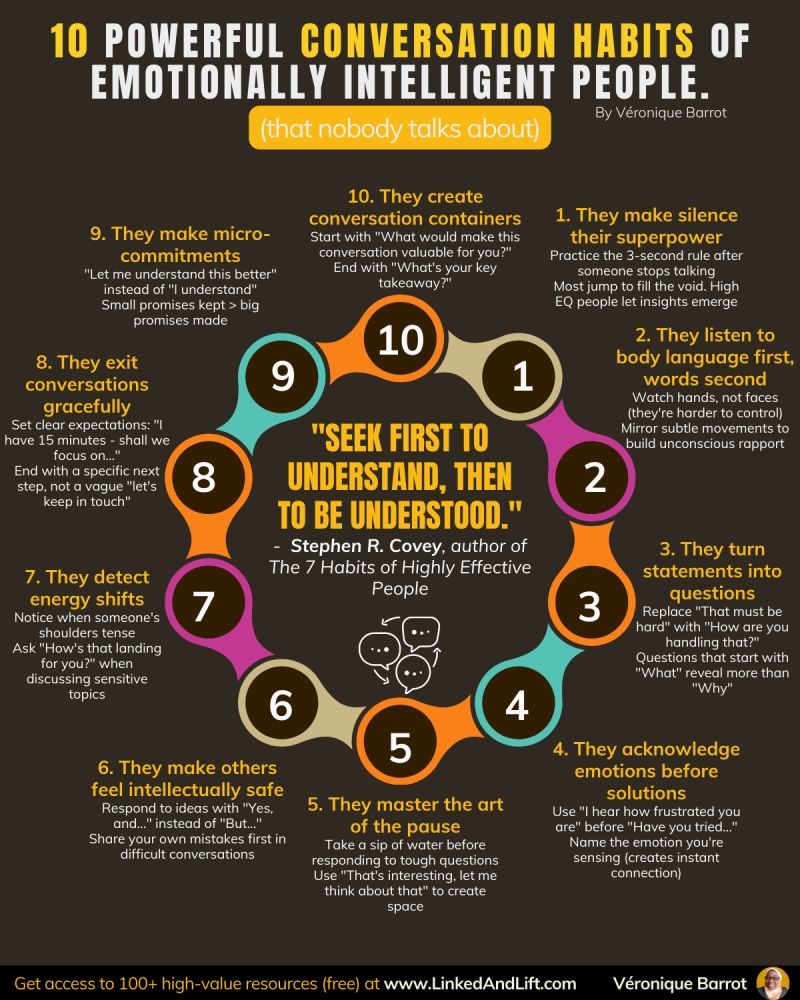5. Identify and Manage Barriers to Strategic Communication
Ever experienced that sinking feeling when your beautifully crafted message—one you carefully designed to be persuasive, and engaging—falls completely flat? Maybe your audience misunderstood your point, didn’t respond at all, or reacted negatively. What happened?
Chances are, you’ve encountered a communication barrier—a sneaky, frustrating obstacle that blocks your message from being understood. Communication barriers are the potholes, detours, and traffic jams of communication—annoying and unavoidable at times, but entirely manageable once you know how to spot them.
Good news: Identifying and managing these barriers isn’t complicated. Let’s uncover these common roadblocks and arm you with practical strategies for smoothly navigating around them. Ready to eliminate confusion and frustration? Let’s dive in!
Common Communication Barrier #1: Information Overload (Too Much, Too Fast)
We live in an age of constant information bombardment—emails, meetings, reports, and endless notifications. Too much information at once overwhelms your audience, causing confusion, frustration, and missed key points.
How to Manage:
Simplify and Focus: Prioritize key messages. Limit your main points to three or fewer per message.
Chunk Information: Break large ideas into smaller, easily digestible segments.
Use Formatting: Bullet points, headings, and visuals help readers absorb information quickly.
Real-world Example:
Overload: “Here’s our new 50-page policy document—please review.”
Managed: “Here’s a brief summary of key policy changes; for details, see page 10.”
Common Communication Barrier #2: Jargon and Technical Language (Alienating Your Audience)
Using jargon or overly technical language when your audience isn’t familiar creates confusion, alienation, and disengagement. Your brilliant message quickly becomes unintelligible.
How to Manage:
Know Your Audience: Adapt your language to your audience’s level of expertise and understanding.
Define Terms: If technical language is necessary, provide simple definitions upfront.
Use Plain Language: Favor everyday language to ensure everyone understands your message.
Real-world Example:
Confusing: “Our CRM solution utilizes advanced data analytics for optimal pipeline visibility.”
Managed: “Our CRM software shows your sales pipeline, making it easy to track leads.”

Veronique Barrot reminds us that listening is the most powerful communication tool. How can you practice deeper listening in your next conversation?”
Common Communication Barrier #3: Emotional Reactions (Feelings Getting in the Way)
Emotions can cloud understanding. Negative emotions like fear, anxiety, or defensiveness block your message’s effectiveness. Failing to anticipate emotional reactions can derail your communication entirely.
How to Manage:
Empathize: Recognize and acknowledge potential emotions upfront (“I know this change might feel overwhelming”).
Frame Positively: Emphasize opportunities and solutions rather than negatives or threats.
Encourage Dialogue: Invite questions and feedback to manage emotional responses effectively.
Real-world Example:
Poor emotional management: “We’re cutting the department’s budget, effective immediately.”
Managed: “Due to recent changes, we’ll carefully adjust spending—let’s discuss how we can manage this effectively together.”
Common Communication Barrier #4: Cultural Differences (Lost in Translation)
Cultural misunderstandings or differences can cause confusion, offense, or misunderstanding. Communication that ignores cultural diversity risks misinterpretation or alienation.
How to Manage:
Understand Cultural Norms: Be aware of your audience’s cultural backgrounds and communication preferences.
Avoid Assumptions: Don’t assume your audience shares your cultural perspective or values.
Use Inclusive Language: Ensure your language respects diverse perspectives and backgrounds.
Real-world Example:
Culturally insensitive: “Everyone celebrates Christmas, so we’ll close during that week.”
Managed: “We recognize diverse holiday celebrations and encourage everyone to communicate your preferences.”
Common Communication Barrier #5: Lack of Feedback (Shouting Into the Void)
Communication isn’t effective if you never receive feedback or confirmation. Without feedback, you’re guessing whether your message landed or fell flat.
How to Manage:
Invite Responses: Ask explicitly for feedback or confirmation (“Please reply by Tuesday to confirm you understand.”).
Follow Up: If no response comes, follow up respectfully (“Just following up to confirm receipt of this message.”).
Encourage Questions: Proactively invite questions or clarifications to confirm understanding.
Real-world Example:
Poor feedback strategy: Sending information without inviting responses or confirmation.
Managed: “Please confirm you received this policy update by replying ‘received’.”
Quick Checklist: Managing Communication Barriers
✅ Each time you communicate strategically, quickly ask yourself:
✅ Have I simplified and prioritized my main points to avoid overload?
✅ Am I avoiding jargon or defining necessary technical terms?
✅ Have I anticipated and managed potential emotional reactions?
✅ Am I respecting cultural differences and using inclusive language?
✅ Have I invited feedback and responses to ensure understanding?
Real-World Scenario: Overcoming Communication Barriers
Imagine introducing a new software tool to your team. Let’s manage potential barriers:
Your managed email:
Subject: Introducing Our Easy-to-Use Project Management Software—Starting Next Week!
Dear Team,
I know adopting new software feels overwhelming at first, so we’ve made it as simple as possible.
Key points explained:
What: New project management tool designed to streamline your work.
Why: Helps us reduce workload and confusion, giving you visibility into your projects.
When: Starting next Monday, with training resources provided.
Next steps stated:
Please watch the short, structured training video attached.
Confirm you’ve watched the video by replying “done” by this Friday.
Questions? Concerns? I welcome your feedback and am here to help!
Thank you for your cooperation and flexibility.
Best,
Alex (Project Manager)
Notice how you managed each communication barrier—simplifying content, avoiding jargon, anticipating emotions, respecting diversity, and inviting feedback. The result? Effective, barrier-free communication.
Final Thoughts: Managing Communication Barriers for Success
Identifying and managing communication barriers isn’t complicated—it’s simply thoughtful preparation and clear execution. By anticipating these common barriers and addressing them proactively, your communication effectiveness skyrockets. You avoid confusion, frustration, and misunderstanding, ensuring your messages always land effectively.
Congratulations—you now have powerful tools for barrier-free, strategic communication every time. Ready to summarize everything you’ve learned in Chapter 4 and move forward confidently? Fantastic—let’s wrap up your strategic communication toolkit!
